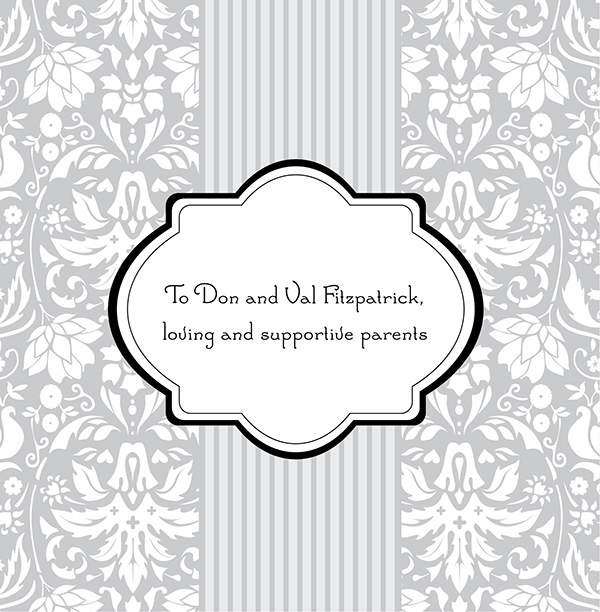Also by Kevin C. Fitzpatrick:
An imprint of Rowman & Littlefield
Distributed by NATIONAL BOOK NETWORK
Copyright 2015 by Kevin C. Fitzpatrick
Foreword copyright 2015 by Anthony Melchiorri
Maps by Melissa Baker Rowman & Littlefield
All rights reserved. No part of this book may be reproduced in any form or by any electronic or mechanical means, including information storage and retrieval systems, without written permission from the publisher, except by a reviewer who may quote passages in a review.
British Library Cataloguing-in-Publication Information Available
Library of Congress Cataloging-in-Publication Data
eISBN 978-1-4930-1673-0 (eBook)
Fitzpatrick, Kevin C., 1966-
The Algonquin Round Table New York : a historical guide / Kevin C. Fitzpatrick ; with a foreword by Anthony Melchiorri.
pages cm
Summary: Explores the shadowy speakeasies, majestic hotels, glittering theaters, and other locations frequented by the legends of the Algonquin Round TableProvided by publisher.
Includes bibliographical references and index.
ISBN 978-1-4930-0757-8 (hardback)
1. Authors, AmericanHomes and hauntsNew York (State)New York. 2. Authors, American20th centuryBiography. 3. Algonquin Round Table. 4. IntellectualsNew York (State)New YorkHistory20th century. 5. IntellectualsNew York (State)New YorkBiography. 6. New York (N.Y.)Intellectual life20th century. I. Title.
PS129.F58 2015
810.90052dc23
2014037678
 The paper used in this publication meets the minimum requirements of American National Standard for Information SciencesPermanence of Paper for Printed Library Materials, ANSI/NISO Z39.48-1992.
The paper used in this publication meets the minimum requirements of American National Standard for Information SciencesPermanence of Paper for Printed Library Materials, ANSI/NISO Z39.48-1992.
Contents
Foreword
A New York City legend in the heart of the Theater District, the Algonquin Hotel is over one hundred years old but as spry as a teenager. Better yet, the spirit of the Round Table is alive and well, forever smiling down on all who pass through the lobby.
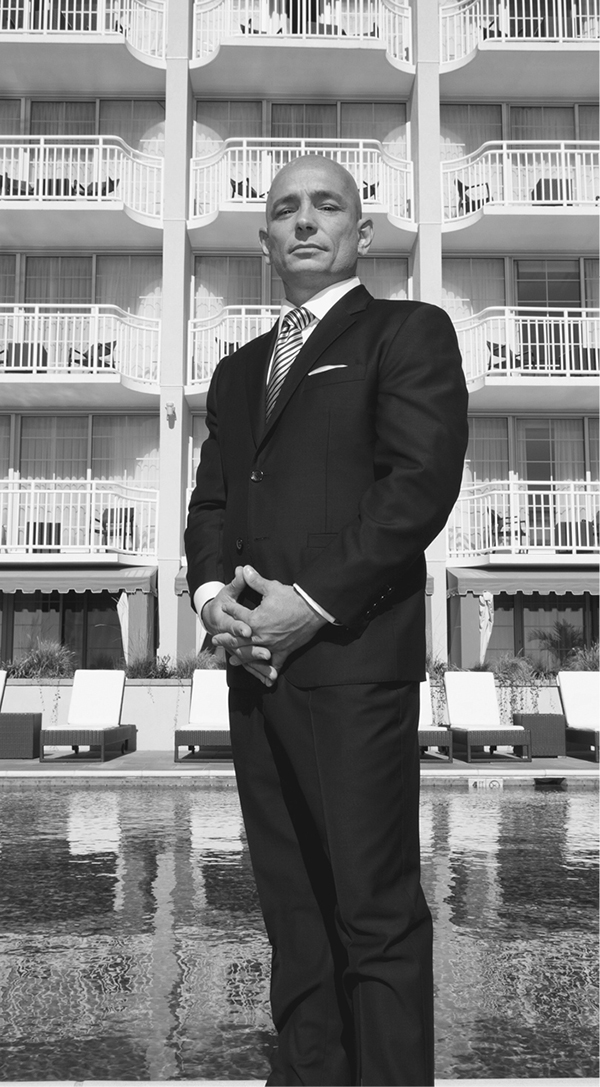
Anthony Melchiorri.
In June 1919 some of Gothams most famous, talented, opinionated, and outlandishly funny writers and critics met one day for lunch. They had such a good time that they met again the next dayand the day after. Their number included columnists, critics, humorists, playwrights, publicists, publishers, and sportswriters. Joining the ranks were occasional friends and lovers, among them actors and novelists of note. But the queen of the prom was Dorothy Parker: critic, poet, short-story writer, and screenwriter. She was everything the hotel was, and is, and these days, the two are inseparable. Both she and the hotel are brilliant, moody, genius, complex, tragic, and, yes, even funny. She and her peers came to The Gonk for lunch six times a week for the next ten years.
Like any hotel, the Algonquin will give you a place to sleep, a bathroom, and something to eat. The rooms are no more special than in most boutique hotels. Theyre comfortable, sure, but theyre still hotel rooms. Except calling the Algonquin just another hotel would be like calling Dorothy Parker just another writer.
I was lucky enough to be general manager of the hotel for two yearsa dream job in the businessbut I came to the Algonquin kicking and screaming. When I arrived in 2004, the place was past its prime, and it looked like a career killer. The risk was huge. On my first day, I walked in thinking that with a good plan and the help of longtime employees, I could rely on history to bring back the hotel. What I didnt realize was the depth of that history and the emotional connection that people have with the place.
The lobby was cool before cool became synonymous with hotels. In fact, this is where the social lobby came into being. It served as a living room for actors, dancers, directors, painters, politicians, and writers, constantly stopping by to schmooze or just hang out. On just one Saturday night during my tenure there, Andrea Marcovicci performed in the Oak Room; Tony Bennett sat in the audience; in the lobby, writer George Will was talking with friends; and Carson Daly was in the Blue Bar trying not to be noticed. Edward Albee, Christine Ebersole, Debbie Harry, Donna Karan, Martin McDonagh, Isaac Mizrahi, Cynthia Nixon, and John Patrick Shanley all made appearances, as did many more, when I was running the hotel.
The Gonk became the first hotel to use electronic keys. It developed the first hotel marketing campaign aimed exclusively toward women. It used the first red rope for crowd control. It was also home to the Algonquin Cocktail, consisting of two shots of rye, one of dry vermouth, and another of pineapple juice. The Vicious Circle was a martini crowd. Thats what they drank before lunch, during lunch, and sometimes instead of lunch. Of course during Prohibition the hotel was officially drywhich may explain why they met here all the time. As Dorothy Parker purportedly wrote:
I love a martini
But two at the most.
Three, Im under the table;
Four, Im under the host.
Ironically, she wasnt much of a martini drinker herself; she preferred the brown stuff: A whiskey sour was more her style. When my team and I were working on a renovation and marketing campaign for the hotel, PR consultant Carla Caccavale said, Heres a place famous for martinis, so why not reinvent the Algonquin Martini?which we did.
We added another noteworthy first to the Algonquins list of achievements: the worlds first $10,000 martini. Early on, I noticed that many couples were getting engaged in our lobby, so I thought, why not make it easier for them? I hired a staff jeweler, who meets with the future groom to pick a diamond. The jeweler then oversees the setting, and when its ready, the couple, along with their family and friends, just happens to stop by for a drink. We deliver our famous martini to the unsuspecting bride-to-be, who discovers an engagement ring at the bottom of her glass. No other martini has produced as many howls of surprise, fits of laughter, rounds of applause, or tears of joy.
We updated the restaurant menus to reflect the Round Table years as well, thanks to owner and first general manager, Frank Case. In the Forties, he authored a book called Feeding the Lions , a reference to the literary lions who made the Gonk their second home. In it, he documented the food served during the height of their fame. All that the head chef and I had to do was sit down and modernize those famous dishes.

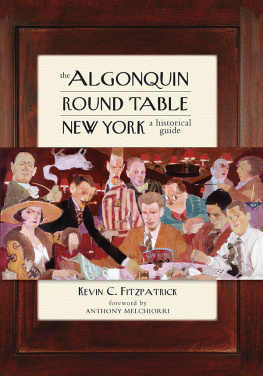



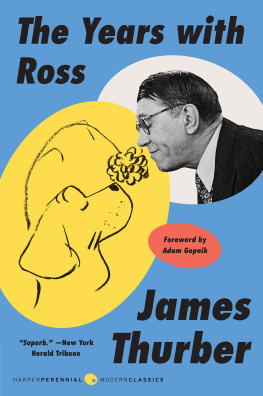


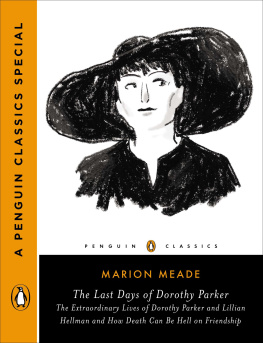



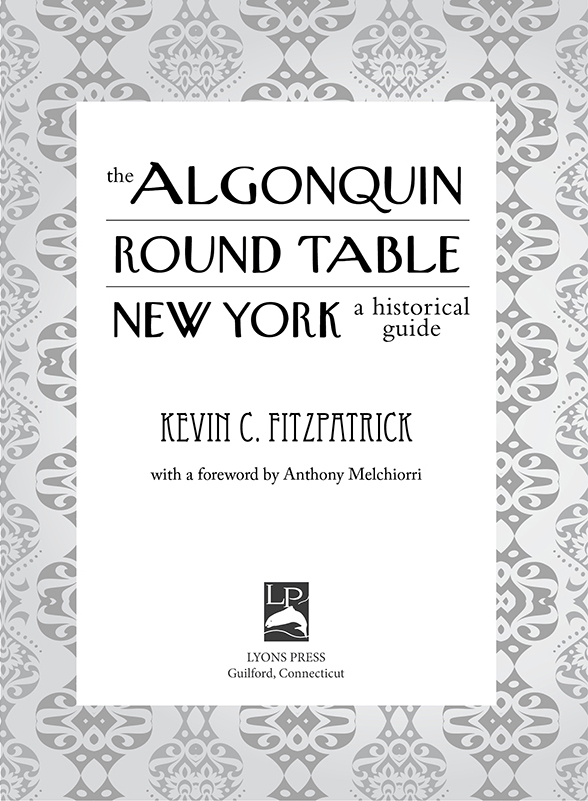

 The paper used in this publication meets the minimum requirements of American National Standard for Information SciencesPermanence of Paper for Printed Library Materials, ANSI/NISO Z39.48-1992.
The paper used in this publication meets the minimum requirements of American National Standard for Information SciencesPermanence of Paper for Printed Library Materials, ANSI/NISO Z39.48-1992.